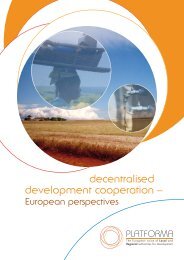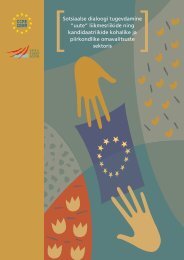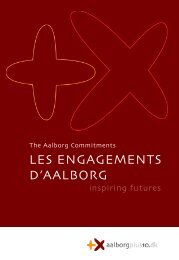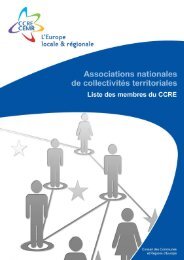Complementarities between urban and rural areas in promoting ...
Complementarities between urban and rural areas in promoting ...
Complementarities between urban and rural areas in promoting ...
You also want an ePaper? Increase the reach of your titles
YUMPU automatically turns print PDFs into web optimized ePapers that Google loves.
COMPLEMENTARITIES BETWEEN URBAN AND RURAL AREAS IN PROMOTING EMPLOYMENT AND SOCIAL INCLUSIONNorthern Karelia, a number of municipalities<strong>and</strong> the F<strong>in</strong>nish Nurses’ Association, who allwork together on this project. Results so far<strong>in</strong>clude the tra<strong>in</strong><strong>in</strong>g of four nurses <strong>in</strong> substanceabuse prevention <strong>and</strong> the preparation of materialfor <strong>in</strong>clusion on the school curriculum ondrug prevention. The organisation “Mothersaga<strong>in</strong>st Drugs” has been founded <strong>in</strong> RussianKarelia. Cross-border student exchange visitshave been organised which deal with the themeof prevent<strong>in</strong>g substance abuse. There have alsobeen activities to promote social <strong>in</strong>clusion skillsamongst students. A computer classroom withten computers was established <strong>in</strong> a school. Therehave been a number of <strong>in</strong>direct results as well asthose, which are already visible. The streets havebecome safer as anti-drug education <strong>in</strong> schoolshas <strong>in</strong>creased <strong>in</strong> Russian Karelia.■ The role of local development <strong>in</strong> meet<strong>in</strong>g the challenges of unemployment<strong>and</strong> social <strong>in</strong>clusion: the EQUAL InitiativeGerhard Bräunl<strong>in</strong>g, DG Employment <strong>and</strong> Social Affairs, European CommissionEQUAL tests new ways of solv<strong>in</strong>g discrim<strong>in</strong>ation<strong>and</strong> <strong>in</strong>equality experienced by those <strong>in</strong> work <strong>and</strong>those who are unemployed. The key pr<strong>in</strong>cipals ofEQUAL are: transnational co-operation, <strong>in</strong>novation,empowerment, thematic <strong>and</strong> partnershipapproach, dissem<strong>in</strong>ation <strong>and</strong> ma<strong>in</strong>stream<strong>in</strong>g.Activities are structured on the four pillars of theEuropean Employment Strategy: Employability,Entrepreneurship, Adaptability <strong>and</strong> Equal Opportunitiesfor women <strong>and</strong> men. It is funded by theEuropean Social Fund (ESF).THE AIM OF THE INITIATIVEThe EQUAL <strong>in</strong>itiative is a response by the EuropeanCommission to a number of questions ontackl<strong>in</strong>g exclusion, discrim<strong>in</strong>ation <strong>and</strong> <strong>in</strong>equality<strong>in</strong> relation to the labour market. It is also designedfor those members of the workforce whohave problems start<strong>in</strong>g new work due to theirsocial, health or family situation. EQUAL promotesnew means of combat<strong>in</strong>g all forms of discrim<strong>in</strong>ation<strong>and</strong> <strong>in</strong>equalities <strong>in</strong> connection withthe labour market through transnational cooperation.EQUAL is an experimental programme to develop,validate <strong>and</strong> ma<strong>in</strong>stream new means of deliver<strong>in</strong>gemployment <strong>and</strong> social <strong>in</strong>clusion policy<strong>and</strong> to undertake this at the local <strong>and</strong> regionallevel. This is also a means by which to empowerlocal <strong>and</strong> regional actors. In other words, EQUALis a laboratory for new forms of <strong>in</strong>tegrative<strong>in</strong>clusive employment. As Ms Diamantopolouonce said: “If we were a production company,then EQUAL would be our laboratory, our developmentarm which develops <strong>and</strong> tests userorientedelements <strong>and</strong> implements them <strong>in</strong>tothe ma<strong>in</strong>stream policies at regional, national<strong>and</strong> European level.”At the European level, two major strategiesexist: The European Employment Strategy, currentlybased on the four pillars (employability,entrepreneurship, adaptability <strong>and</strong> equal opportunities)<strong>and</strong> the European Social Inclusion Strategy.Both strategies follow a similar pattern ofopen coord<strong>in</strong>ation <strong>and</strong> try to <strong>in</strong>tegrate local <strong>and</strong>regional actors <strong>and</strong> their experience. The problemis how this is done <strong>and</strong> one of the solutionsto this is through learn<strong>in</strong>g.EQUAL <strong>in</strong>itiatives br<strong>in</strong>g together all relevantactors. Transnationality is illustrated through acomb<strong>in</strong>ation of experience, learn<strong>in</strong>g from others<strong>and</strong> learn<strong>in</strong>g from experiences <strong>in</strong> other memberstates. Secondly, there is the aspect of partnership:there are no s<strong>in</strong>gle projects. These <strong>in</strong>dividualprojects are part of a set of projects whichare driven by partnership of local <strong>and</strong> regionalauthorities, social partners, tra<strong>in</strong><strong>in</strong>g agencies, aswell as NGOs. It cannot be assumed that partnershipswork. Consequently the fund<strong>in</strong>g arrangementwas changed <strong>and</strong> a preparation periodof at least 6 months was decided on. The idea— 19 —














![[ ] Les jumelages pour le monde de demain](https://img.yumpu.com/29721946/1/190x96/-les-jumelages-pour-le-monde-de-demain.jpg?quality=85)

